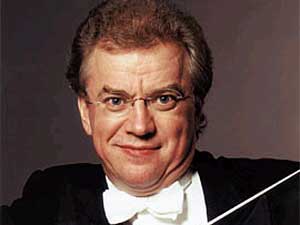|
Audio
Photos
Resources
|
February 11, 2005
It's perhaps the best known opening in classical music, the crashing chords of Beethoven's Fifth Symphony. The Minnesota Orchestra has released a new recording of the work, and is kicking off a 10-day "Beethoven Blitz" to mark the CD's release. When many orchestras are recording less because of economic concerns, some are asking if there's really a need for another rendition of Beethoven's Fifth.
Minneapolis, Minn. — When Osmo Vanska's record label asked him to record the complete cycle of Beethoven Symphonies with the Minnesota Orchestra, he responded with a question of his own.
"Are you crazy?" he laughs.
Vanska says he usually makes decisions very quickly, but it took him a few weeks to decide whether he wanted to record the cycle. After all, there are more than 200 CDs of Beethoven symphonies currently in print, including classic interpretations by such legendary conductors as Herbert von Karajan, George Szell and Wilhelm Furtwangler. Vanska was reluctant at first, because he was unsure if he had anything fresh to say.
"I had many conversations with different people," he says. "And finally I was convinced this was the right decision, and we have to go with that great challenge for the orchestra, a great challenge for the conductor. Because there are so many (recordings), the competition is, let's say, with the best orchestras, and best conductors in the world. But I love to do Beethoven, and I just believed that we had something new to bring to that music."
When Osmo Vanska finally decided to record the Beethoven symphonies with the Minnesota Orchestra, he thought the project would be either a triumph or a disaster. If the critical response to the release of the fourth and fifth symphonies is any measure, it's been a triumph.
Greg Sandow is a frequent critic for the Wall Street Journal and a consultant for several top American symphonies. His response is simple.
"I was just knocked out."
Sandow says Osmo Vanska brings to the music a passion bordering on ferocity.
"There were two things I noticed especially. One was just a kind of rhythmic life, a presence, suppleness, a verve, a kind of bounce," says Sandow. "And then some beautiful turns of phrasing, and not simply in places where you would expect to encounter them, like major turning points in the piece, utterly gorgeous melodies that can be milked for all they are worth, but even very small turns of phrase."
St. Paul writer and critic Larry Fuchsberg, who is a regular contributor to the Star Tribune, also praises the CD for its dynamic range, and calls Vanska the master of the "orchestral whisper." He also hears a controlled coolness that is in marked contrast to the more dramatic interpretations by the great conductors of the past.
"These are very carefully plotted performances. One has the sense that every gesture has been calculated. There isn't a great sense of spontaneity here. It's not the kind of performance that gives you the illusion the music is being invented as it's being played," says Fuchsberg. "But the playing is spectacularly good and together. The recording clarifies the textures wonderfully. There is often the sense that you are hearing something that was subliminally there before, but never really as pronounced as you are getting it from this particular CD."
The initial release in the Minnesota Orchestra's Beethoven cycle comes at a difficult time for the classical music recording industry.
The major labels are concentrating on crossover recordings, and a few easily marketable artists whose CDs will turn a profit. They're no longer recording American symphony orchestras because, among other reasons, it makes more financial sense to just re-issue older recordings of the basic repertoire.
Greg Sandow says this forces a tough question. With a classic recording of Beethoven's Fifth by, say, George Szell and the Cleveland Orchestra still available, why make a new one with Osmo Vanska and the Minnesota Orchestra?
"If you want to really play hardball with this, you say, 'Given how many times these symphonies have been recorded and in many cases by such great conductors, do we actually need this?' And the answer might be, 'No,'" says Sandow. "I can't say it's absolutely essential that these things have happened. But since they did happen, I am absolutely thrilled that they are there. That may sound paradoxical, but that's more or less how I look at it."
But on the other hand, Greg Sandow says, this is 2005, and today's conductors and musicians should have a say in this music.
Larry Fuchsburg agrees, and says there's room for more than just the classic recordings of Beethoven's symphonies.
"Each generation has to try to re-invent these pieces for itself, or they are going to wither and die," says Fuchsberg. "A work of art has a lifespan. And it can grow and prosper, and it can also wither and expire, and this is a more than plausible Beethoven for our time."
The Minnesota Orchestra is scheduled to record the next installment in the cycle, Beethoven's Ninth, later this summer. The orchestra begins a five-city tour of Minnesota next week with performances of Beethoven's Fourth and Fifth Symphonies in Northfield, Windom, Sauk Centre, Willmar and Dassel-Cokato.




